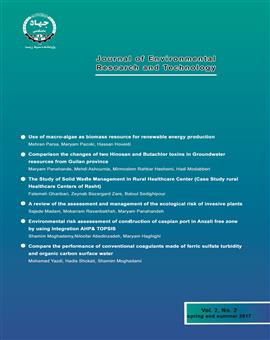-
-
List of Articles
-
Open Access Article
1 - Use of macro-algae as biomass resource for renewable energy production
mehran parsa Maryam Pazoki hassan hoveidi -
Open Access Article
2 - Comparison the changes of two Hinosan and Butachlor toxins in Groundwater resources from Guilan province
maryam panahandeh mehdi ashournia Mirmoslem Rahbar hashemi hadi Modabberi -
Open Access Article
3 - The Study of Solid Waste Management in Rural Healthcare Center (Case Study rural Healthcare Centers of Rasht)
fatemeh ghanbari zeynab bazargard batol sedighi -
Open Access Article
4 - A review of the assessment and management of the ecological risk of invasive plants
ساجده مدنی mokarram ravanbakhsh مریم پناهنده -
Open Access Article
5 - Environmental risk assesssment of construction of caspian port in Anzali free zone by using Integration AHP& TOPSIS
shamim moghadami niloofar Abedinzade Maryam Haghighi khomami -
Open Access Article
6 - Compare the performance of conventional coagulants made of ferric sulfate turbidity and organic carbon surface water
-
The rights to this website are owned by the Raimag Press Management System.
Copyright © 2017-2025







